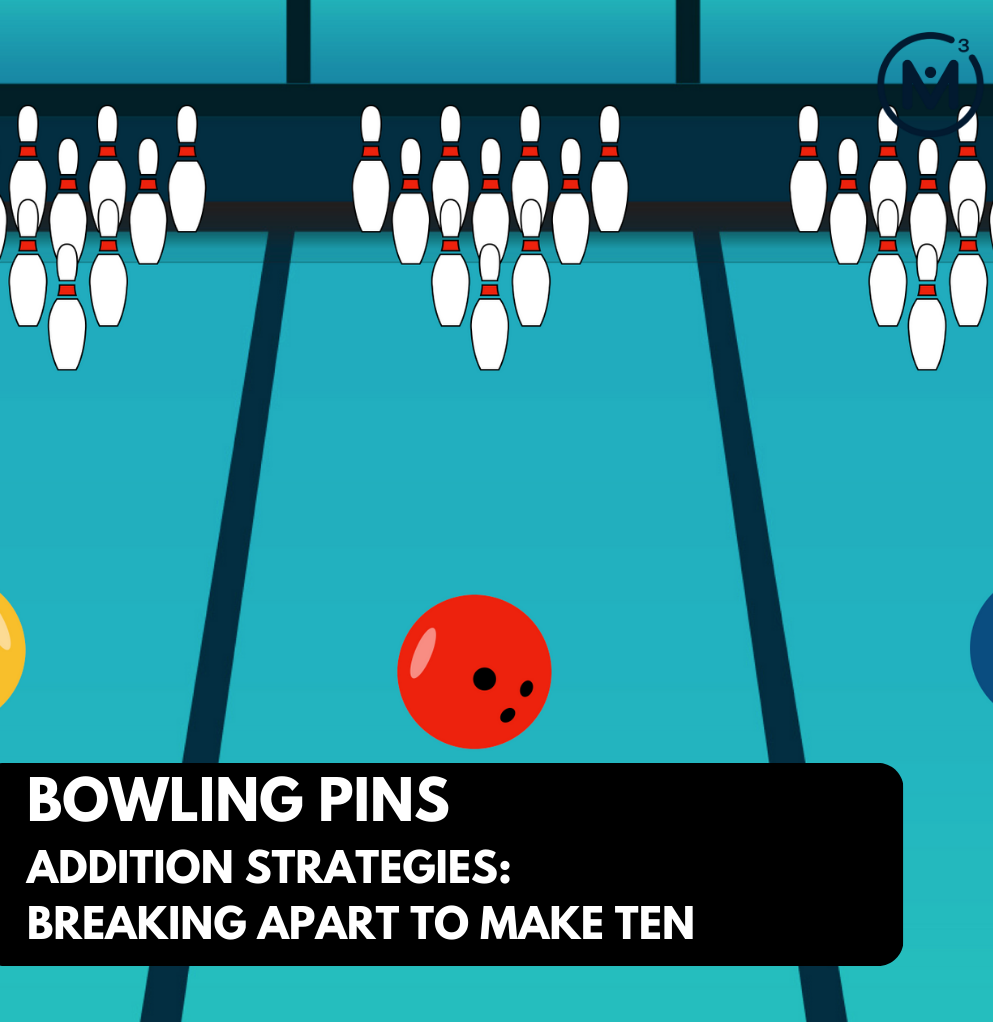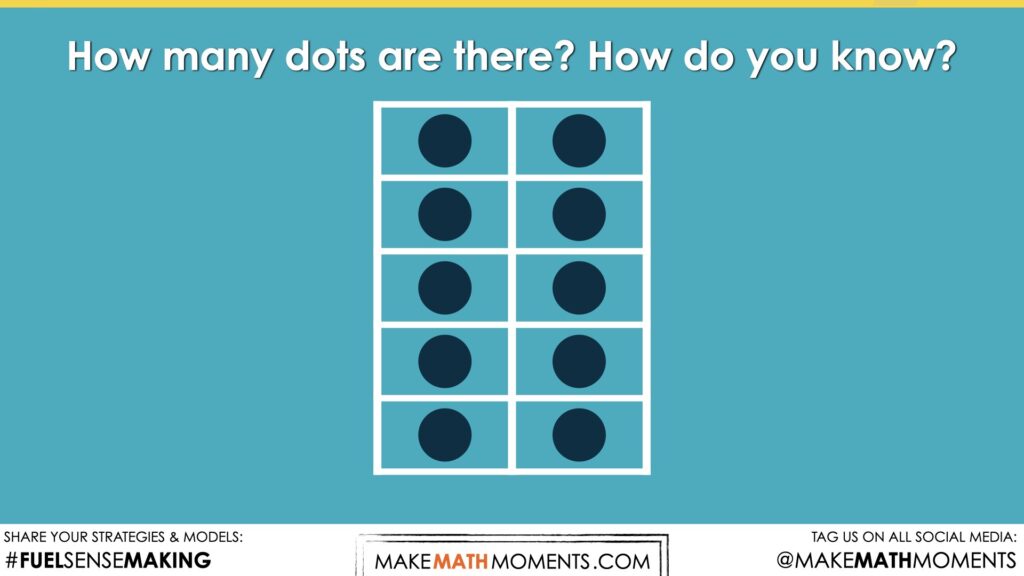BOWLING PINS [DAY 2]
ADDITION STRATEGIES: BREAKING APART TO MAKE TEN
Explore addition through the strategy of breaking apart to make ten.
Intentionality
Math Talk
Visual Math Talk Prompt #1
Visual Math Talk Prompt #2
Visual Math Talk Prompt #3
Visual Math Talk Prompt #4
Visual Math Talk Prompt #5
Purposeful Practice
Resources & Downloads
Educator Discussion Area
Intentionality & Unit Overview

Length of Unit: 5 Days
Access each lesson from this unit using the navigation links below
Students will continue composing ten with a visual number talk and purposeful games/ small group activities.
Intentionality…
In this task, students will explore the combinations of ten from Day 1. A number talk using the ten frame as a tool to provide a visual for students and games to reinforce the multiple combinations that make ten.
Big ideas of the unit:
- Understanding hierarchical inclusion allows for flexible composing and decomposing of numbers
- Numbers can be decomposed by separating a whole into two or more parts
- Addition names the whole in terms of the parts: when the parts of a set are known we call it addition
- Different addition situations will elicit different strategies
- Number relationships provide the foundation for strategies to help students remember basic facts
- Commutative and Associative property of addition can be used to help learn facts
- Models can be used to connect concrete to abstract.
Math Talk
The visual number talks are displayed using a ten frame. Each video will present the ten frames for a short period of time. This will encourage students to subitize the amounts rather than counting one by one. If needed, provide students with a ten frame and counters on their desk so they can duplicate the image presented. Provide students time to turn and talk to a neighbour to confirm their guesses before discussing with the class. Encourage students to explain how they saw the dots.
If needed, start the video again to provide an opportunity for students to confirm their thinking.
The ten frame is a good visual model to familiarise students with the value of a number. When working with the ten frame, the students can see the amount of dots that number represents. This will assist with their number sense.
Each ten frame will be shown for 2 seconds. Ask the students:
How many dots?
How do you know?
Pause the video to allow for think time and class discussion.
Resume the video with the following prompt:
How many more to make 10?
How do you know?
Visual Math Talk Prompt #1
Begin playing the following visual number talk prompt video and be ready to pause the video to allow for think time.
Ask students to turn and talk to a neighbour to confirm the amount that they saw. Students can share answers with the class explaining how they saw the dots on the ten frame.
It is important to confirm that when the ten frame is “full”, it is ten.
Ask students:
When the ten frame is full, do we have to count the amount?
How do we know the amount without counting?
Even if students say it, be sure to reiterate:
We know when the ten frame is full, it will always be ten.
This is encouraging students to trust the count and feel comfortable with the ten frame image.
Visual Math Talk Prompt #2
Begin playing the following visual number talk prompt video and be ready to pause the video to allow for think time.
Ask students to turn and talk to a neighbour to confirm the amount that they saw. Students can share answers with the class explaining how they saw the dots on the ten frame.
Some students may recognize that half of the ten frame is filled so it must be 5. They may use their understanding of the doubles fact 5 + 5 makes 10.
Again, students may use that doubles fact of 5 to explain their answer. They may also be able to visualize the ten frame in their head to know that there were 5 missing on the right side. Some students may also use their fingers to determine the amount needed to make 10.
Visual Math Talk Prompt #3
Begin playing the following visual number talk prompt video and be ready to pause the video to allow for think time.
Ask students to turn and talk to a neighbour to confirm the amount that they saw. Students can share answers with the class explaining how they saw the dots on the ten frame.
Using the information from the last prompt, students may recognize 7 as being 2 more than 5.
Ask students:
If we knew that this was 5 from the last question, do we have to recount it? Why not?
How can we count on from 5 to find our answer?
Students may be able to visualise the remaining spaces that did not have dots in them.
Some students may use their fingers to make 7 then count or subitize the remaining amount to make 10.
Encourage students to share their thinking with the class to demonstrate ways to find a missing amount when one value is known.
Visual Math Talk Prompt #4
Login/Join to access the entire Visual Prompt, downloadable slide decks and printable handouts for this lesson and all problem based units.
Visual Math Talk Prompt #5
Login/Join to access the entire Visual Prompt, downloadable slide decks and printable handouts for this lesson and all problem based units.
Purposeful Practice
While Students Are Practicing…
Login/Join to access the entire Teacher Guide, downloadable slide decks and printable handouts for this lesson and all problem based units.
Purposeful Practice Game: Spin a Ten
Login/Join to access the entire Teacher Guide, downloadable slide decks and printable handouts for this lesson and all problem based units.
Small Group Activity / One-On-One Activity
Login/Join to access the entire Teacher Guide, downloadable slide decks and printable handouts for this lesson and all problem based units.
Resources & Downloads
Login/Join to access the entire Teacher Guide, downloadable slide decks and printable handouts for this lesson and all problem based units.
Printable Lesson Plan PDF
Videos, Images & Media Files
Apple Keynote Presentation
Powerpoint Presentation
Printable Consolidation Prompts
Educator Discussion Area
Login/Join to access the entire Teacher Guide, downloadable slide decks and printable handouts for this lesson and all problem based units.
Explore Our 60+ Problem Based Units
This Make Math Moments Lesson was designed to spark curiosity for a multi-day unit of study with built in purposeful practice, number talks and extensions to elicit and emerge strategies and mathematical models.
Dig into our other units of study and view by concept continuum, grade or topic!









